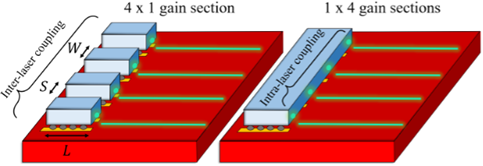This study investigates how scaling the size of laser arrays has strong implications for self-heating and optical performance.
 Two variants of a laser array. Image Credit: IEEE Photonics Society
Two variants of a laser array. Image Credit: IEEE Photonics Society
Multi-wavelength light sources are required for optical transceivers to increase data. However, scaling the laser array size increases thermal crosstalk, which may affect laser efficiency and reliability.
In a new study published in IEEE Journal of Selected Topics in Quantum Electronics, Dr. David Coenen and his team developed an experimentally validated thermo-optic laser model. The model is demonstrated for a case study where a transceiver with 64 laser output channels is required. To identify the configuration which is energy efficient, reliable and occupies a small area, the following input parameters were studied: how many lasers can fit in one die, laser die size, output power per laser gain, ambient temperature, thermal management strategy and finally integrated vs. external laser.
We found several interesting conclusions: there exists a clear trade-off between laser array area and overall thermal resistance. A smaller array area will drastically increase the thermal crosstalk and temperature. Furthermore, increasing the laser length allows the generation of more light per gain section and decreases laser thermal resistance. This must, however, be balanced against the additional optical losses induced by the long gain section. Increasing laser width, and putting more lasers in one die, drastically increases thermal crosstalk.
Finally, external lasers, which need to overcome fiber coupling losses, suffer at high ambient temperatures and have more difficulty reaching the required output power. However, an advantage of an external laser is that it can be thermally decoupled from any high-power electronic chips, e.g. a network switch with co-packaged optics. These results will help designers to understand the trade-offs in laser array design, providing tools to evaluate the impact of design choices and key performance metrics. More model validation results will be published at the CLEO conference.